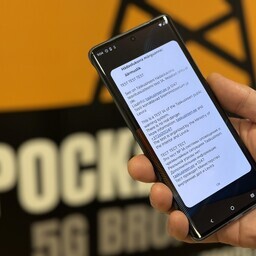Taskusireeni tehnoloogia saadab teavituse nutitelefoni. Teavitust edastatakse heli, valguse ja vibratsiooniga. Teavituse saab ka siis, kui operaatori võrk ei tööta või telefon on vaiksel režiimil.
Testvõrk katab Harju-, Pärnu-, Järva-, Ida-Viru-, Lääne-Viru-, Rapla-, Viljandi- ja Tartumaad. Testimine toimub Tallinnas, Pärnus ja Rakveres, sest suurtes linnades on lihtsam leida vabatahtlikke testijaid.
Taskusireeni testimisel testitakse
alternatiivset võrku ohuteate edastamiseks
. Tallinnas, Pärnus ja Rakveres on
mastid, mis saadavad raadiosignaale
.
alternatiivset võrku ohuteate edastamiseks
Tõlge fraasile: alternatiivset võrku ohuteate edastamiseks
EN
alternative network for emergency alerts
mastid, mis saadavad raadiosignaale
Tõlge fraasile: mastid, mis saadavad raadiosignaale
EN
masts that transmit radio signals
Testimise käigus saadetakse
ohuteavituse testsõnum
. Testitakse, millistesse seadmetesse sõnum jõuab. Mõned seadmed saavad saata ohuteavitust satelliidi koordinaatide täpsusega.
ohuteavituse testsõnum
Tõlge fraasile: ohuteavituse testsõnum
EN
test emergency alert message
Levira on tuvastanud 12 nutiseadme mudelit, mis toetavad
ringhäälingusagedusi
. Tavakasutajad ei peaks sõnumit saama, kuid mõned välismaistest telefonidest võivad selle saada.
ringhäälingusagedusi
Tõlge fraasile: ringhäälingusagedusi
EN
broadcasting frequencies
Sõnumis kirjeldatakse, et tegemist on testsõnumiga. Sõnum on eesti, vene ja inglise keeles. Kui keegi saab selle sõnumi, palutakse anda
tagasisidet taskusireen.ee veebilehel
.
tagasisidet taskusireen.ee veebilehel
Tõlge fraasile: tagasisidet taskusireen.ee veebilehel
EN
feedback on the taskusireen.ee website
Taskusireeni tehnoloogia põhineb
5G ringhäälingutehnoloogial
. Ükski riik ei kasuta veel täielikult 5G tehnoloogiat. Arendustöö on suunatud sellele, et telefonid hakkaksid edastama
tele- ja raadioteenuseid
.
5G ringhäälingutehnoloogial
Tõlge fraasile: 5G ringhäälingutehnoloogial
EN
5G broadcasting technology
tele- ja raadioteenuseid
Tõlge fraasile: tele- ja raadioteenuseid
EN
television and radio services
Alternatiivset võrku on vaja viimaste aastate sündmuste tõttu Euroopas. Näiteks Hispaanias ja Portugalis oli
pikem elektrikatkestus
, kus mobiilsidevõrk lakkas töötamast.
pikem elektrikatkestus
Tõlge fraasile: pikem elektrikatkestus
EN
prolonged power outage
5G ringhäälingutehnoloogia võib Euroopas laiemalt kasutusele tulla selle kümnendi lõpus. Tulevikus võib see olla üks peamisi ohuteavituse kanaleid.
Taskusireeni projekti juhivad siseministeerium, päästeamet, kaitsevägi ja teised asutused. Tehnoloogilise arenduse ja testimisega tegelevad Levira, TalTech, Tredess ja Nakolos.
Taskusireeni arendamine algas 2025. aastal ja kestab 2026. aastani. Projekti eesmärk on tutvustada ja testida 5G broadcast tehnoloogiat
avalike hädaolukorra teadete edastamiseks
.
avalike hädaolukorra teadete edastamiseks
Tõlge fraasile: avalike hädaolukorra teadete edastamiseks
EN
for transmitting public emergency alerts
Pocket siren technology sends a notification to a smartphone. The notification is transmitted via sound, light, and vibration. The notification can also be received when the operator's network is down or the phone is in silent mode.
The test network covers Harju, Pärnu, Järva, Ida-Viru, Lääne-Viru, Rapla, Viljandi, and Tartu counties. Testing takes place in Tallinn, Pärnu, and Rakvere because it is easier to find volunteer testers in larger cities.
During the pocket siren testing, an alternative network for emergency alerts is being tested. In Tallinn, Pärnu, and Rakvere, there are masts that transmit radio signals.
During the testing, a test emergency alert message is sent. The test checks which devices receive the message. Some devices can send emergency alerts with satellite-level coordinate accuracy.
Levira has identified 12 smartphone models that support broadcast frequencies. Regular users should not receive the message, but some foreign phones might receive it.
The message states that it is a test message. The message is in Estonian, Russian, and English. If someone receives this message, they are asked to provide feedback on the taskusireen.ee website.
Pocket siren technology is based on 5G broadcast technology. No country is yet fully using 5G technology. Development work is aimed at enabling phones to transmit TV and radio services.
The alternative network is needed due to recent events in Europe. For example, Spain and Portugal experienced prolonged power outages where mobile networks stopped working.
5G broadcast technology could be more widely adopted in Europe by the end of this decade. In the future, it could become one of the main emergency alert channels.
The pocket siren project is led by the Ministry of the Interior, the Rescue Board, the Defense Forces, and other institutions. Technological development and testing are handled by Levira, TalTech, Tredess, and Nakolos.
The development of the pocket siren began in 2025 and will continue until 2026. The project aims to introduce and test 5G broadcast technology for public emergency alerts.

